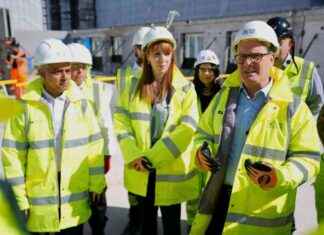For the rescuers, it was not easy to extract the body of the young woman from the rubble of her village, pulverized during the deadliest earthquake that Morocco has known for more than sixty years. Her 25-year-old fiancé, Omar Aït Mbarek, watched the excavations on Sunday, his eyes red and full of tears, surrounded by a few residents, just a few kilometers from the epicenter of the earthquake in the Atlas Mountains.
He was on the phone with the young woman when the shaking started Friday evening, and he heard kitchen utensils crashing to the floor before the line was cut. He knew she was gone. ” What do you want me to say ? I am bruised,” he told Agence France-Presse after Mina Aït Bihi, who was to become his wife in a few weeks, was taken in blankets to a makeshift cemetery where 68 people were already buried. other people.
The men who carefully removed the dirt from her by hand also found her phone and handed it to the young man. All around him, the village of Tikht, once home to at least 100 families, is a tangle of wood, masonry debris, broken plates, shoes and intricately patterned carpets. “Life is over here,” asserted Mohssin Aksoum, 33, part of whose family lives in this small village. “The village is dead. » Like many hard-hit villages, it was a small settlement with many buildings constructed in the traditional way using a mixture of stone, wood and mud mortar. Dozens of residents, grieving relatives and soldiers gathered in the ruins on Sunday.
Many said they did not remember any other earthquakes in the region. “It’s not something people here thought about when they were building their houses,” said Abdelrahman Edjal, a 23-year-old student who lost a large part of his family in the disaster. But the quality of building materials is not the first concern of the student sitting on a rock among the rubble, under a bright blue sky and surrounded by mountains.
He was out for a walk after dinner when the tremors started and he saw people trying to escape their collapsing homes. He rescued his own father from the ruins of the family home, but his injuries were too severe. He succumbed alongside his son. Daily life was already tough in the region, about a two-hour drive from Marrakech and the jobs offered by its tourism sector.
Aksoum, originally from the village but who lives in Rabat, is sad that the earthquake took away what little people had. Pointing to his nose, he explains that the ambient odor comes from livestock, the only wealth of many inhabitants, buried under the rubble and which is beginning to rot. “Now people have less than nothing. » As he spoke, two young men with clothes stained with the white dust of the ruins sat on rocks and wept, without saying a word. Yellow tents, serving as emergency shelters, were visible on the road leading into town.
Members of the Civil Protection transported cots from a military truck to the tents. NGOs were also present in the region, assessing the needs other than housing, food and water, of residents remaining in villages like Tikht. Several residents said that, shocked by their losses and the extent of the damage, they did not know what to do. But Omar Aït Mbarek said he was sure of one thing: “I will rebuild my house”, with his late fiancée’s dust-covered phone in his hand, before walking away into the rubble.






